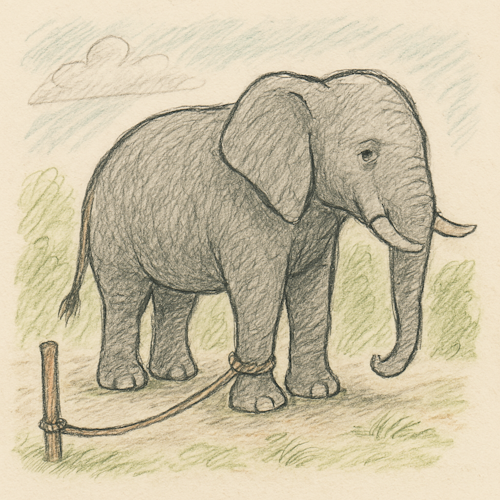The Elephant & The Ropes
Illustrates Limiting Beliefs, Organizational Inertia, Psychological Constraint
In many Agile transformations, teams struggle not because of external blockers but because of mental ones. Legacy thinking, learned helplessness, and invisible constraints often hold back progress long after the actual limits are gone. The Elephant & The Ropes parable is a powerful metaphor for understanding how these internal boundaries get in the way of meaningful change.

When elephants are young, trainers tie a thick rope around their leg and anchor it firmly to the ground. The baby elephant pulls, tugs, and fights. But the rope holds firm. Eventually, the elephant gives up.
As the elephant grows, it becomes strong enough to snap the rope with ease. But it never tries. Why? Because it still believes it cannot break free. The rope is no longer a physical constraint. It is a mental one.
So the full-grown elephant stands still, tethered by a rope that no longer binds it. What once was true has become a story it tells itself. And the story is stronger than the rope.
Lessons Learned
Beliefs Are More Binding Than Rules
Many Agile teams operate within assumptions that were valid once but are no longer true. "We can't release mid-sprint." "Leadership won't support that." "The tool doesn't allow it." These may have been accurate in the past, but over time they become unexamined truths. The rope is gone, but the team still stands still.
Change Fails When Mindsets Stay the Same
Even when frameworks, tooling, and roles are updated, transformation falters if people remain bound to their old stories. Changing process is surface-level. Changing belief requires trust, experience, and safe exploration. Agile is not a set of mechanics. It is a shift in what teams believe is possible.
Small Traumas Create Large Shadows
A missed opportunity. A failed experiment. A bad leadership decision from years ago. These moments form scars. Teams stop trying. When asked why, they say, "It won't work here." But often, the only thing in the way is memory. We must name these ghosts or they quietly define the future.
Freedom Is Uncomfortable
Breaking the rope sounds easy, but it requires courage. It also requires support. A team may hesitate to test its strength because failure could prove the rope is still real. But success brings uncertainty too. What do you do once you realize you're free? Agile coaches help teams build confidence in that freedom.
Real Constraints Deserve Inspection Too
Not every rope is imaginary. Some are policies, regulations, or technical limitations. The point is not to pretend they don't exist. The point is to examine them. Agile teams do not accept constraints without question. They explore. They ask. They challenge. Sometimes, the knot is looser than it looks.
Coaching Tips
- Spot the Phantom Ropes: When a team says "we can't", dig deeper. Ask, "What would happen if we tried?" Use curiosity, not confrontation. Often, the only thing missing is permission.
- Use Retrospectives to Unlearn: Invite teams to identify outdated assumptions they are still following. What used to be true but might not be anymore?
- Make Safe Rope Tests: Help teams run small, low-risk experiments to challenge their boundaries. Success builds confidence. Even failure brings clarity.
- Coach the Story, Not Just the Structure: Agile success depends less on the framework and more on the narrative teams carry about their own power. Help them rewrite it.
- Remind Leaders Their Past Shapes the Present: Many organizational ropes were tied by leadership. Invite those same leaders to untie them. It sends a powerful message of support.
Agile is not just about doing different. It is about believing different. The Elephant & The Ropes reminds us that invisible barriers can be stronger than real ones. Teams do not always need new tools. Sometimes they just need to remember they are not tied down anymore.
If your team is standing still, ask: what story are we still believing? Then help them test the rope. They may discover it was never there at all.


